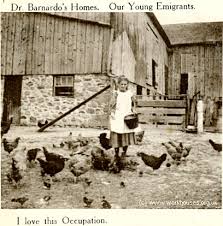A British Home Child/Child Migrant Worker
From the early 1860s up to the 1970s, children who were institutionalized in ‘Homes’ across the UK, were sent, to countries across the British Empire to be used as indentured farm workers and domestics.
The majority of the up to 120,000 British Home children sent to Canada, arrived between 1869 and 1939. Mostly, they ranged in age from four to fifteen.
The scheme had its beginning during the Industrial Revolution, when many families migrated from rural areas to urban areas in the UK to find work. Traditionally, families had stayed in one area and if need arose, children would be taken care of by distributing them amongst family.
Moving to urban areas, families were cut off from this traditional support system,and when death, illness or abandonment of one parent forced the remaining parent to look for alternative help, philanthropic organizations sprang up all over the country to help these needy children. There were no governmental institutions in place. Contrary to popular opinion, most of the children were surrendered to these institutions by their parents and were not found on the street.
Started with good intentions, Annie MacPherson, Barnardo’s, Quarriers, The Salvation Army, The Liverpool Sheltering Homes, and The Church of England, to name but a few of the over 50 organizations, were quickly overrun with impoverished children.
An appealing solution was quickly found – send these children to the colonies to fresh air and hard work on farms and domestic jobs in a new country. Farmers, some poor themselves, were all too happy to pay low wages for help. Canada was especially marketed to the parents and young, as a safe haven amidst the storm of their lives.
 Sometimes turning their children over to the institutions was meant as a temporary measure but when the parents returned to pick up their children, they found that their offspring had already been sent to a far-off country. Some parents received a notice that their child was selected for immigration the following week, while others were sent an ‘after sailing’ notice telling them that their child had already been sent.
Sometimes turning their children over to the institutions was meant as a temporary measure but when the parents returned to pick up their children, they found that their offspring had already been sent to a far-off country. Some parents received a notice that their child was selected for immigration the following week, while others were sent an ‘after sailing’ notice telling them that their child had already been sent.
Once in Canada, children were sent to receiving homes. These were situated right across Canada. Farmers or households were required to apply for children. There were seven applicants for every child.
This where the system began to break down. Siblings were separated upon their arrival here and though some of the farmers genuinely cared for the children, many just saw them as cheap labour. Others submitted them to abuse of a horrific nature.
Monitoring a child’s placement was usually left up to the luck of the draw, although some organizations contacted members of the parish they were in to see if the applicants were decent members of society. In any case, applicants could return children if deemed unsuitable and some were placed many times.
Many of the British Home Children were stigmatized by the communities meant to foster them. Often they were told by their masters that they were street rats or just ‘workers’ and to make themselves scarce if anyone visited. Some were ridiculed and blamed for any bad situation that developed in the community. They suffered in silence, refusing to tell even their immediate family where they had come from.
 There were others, though, that developed long-lasting relationships with the families they were placed with – to the extent of listing them as their next-of-kin when they enlisted in the Canadian army during both world wars.
There were others, though, that developed long-lasting relationships with the families they were placed with – to the extent of listing them as their next-of-kin when they enlisted in the Canadian army during both world wars.
This emigration scheme, which was abandoned during the First World War, began again in earnest in the twenties. There were many children left fatherless by the war and many children were left parent-less by the Spanish ‘flu.
By 1924, social consciousness had changed somewhat and children under the age of 14 were strongly discouraged by influential individuals from being sent to Canada
After the beginning of the Second World War, the child emigrant scheme came to an end in Canada for the most part. However, children were still being sent to Australia until the 1970s.
Over ten percent of the Canadian Population is a descendant of a British Home Child although many are still unaware of this part of their background.

